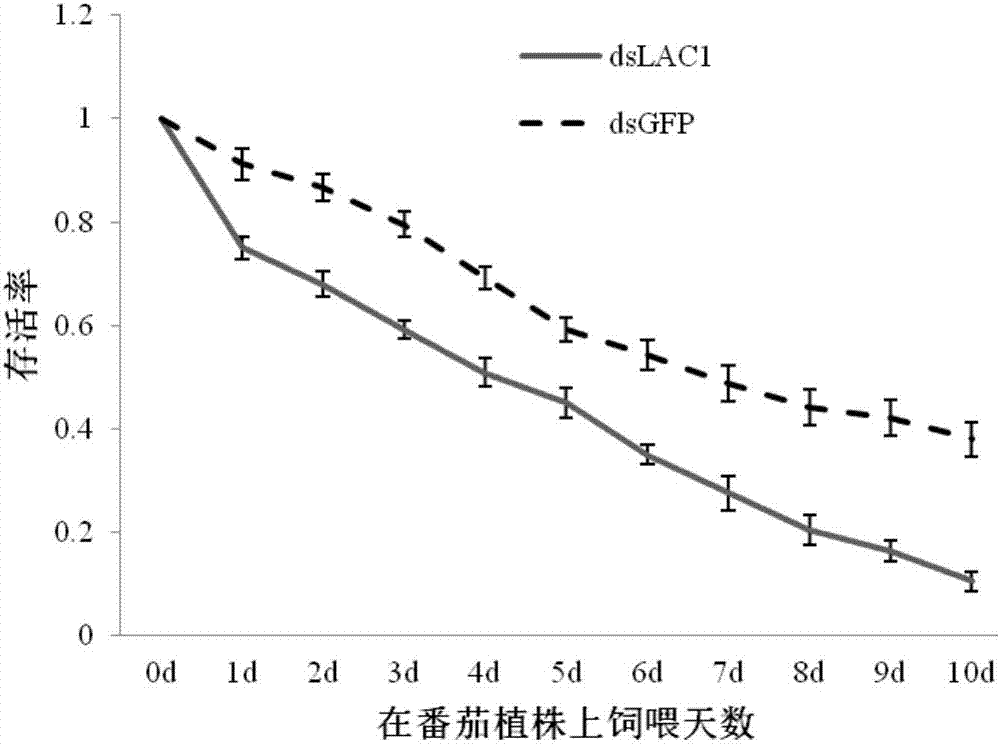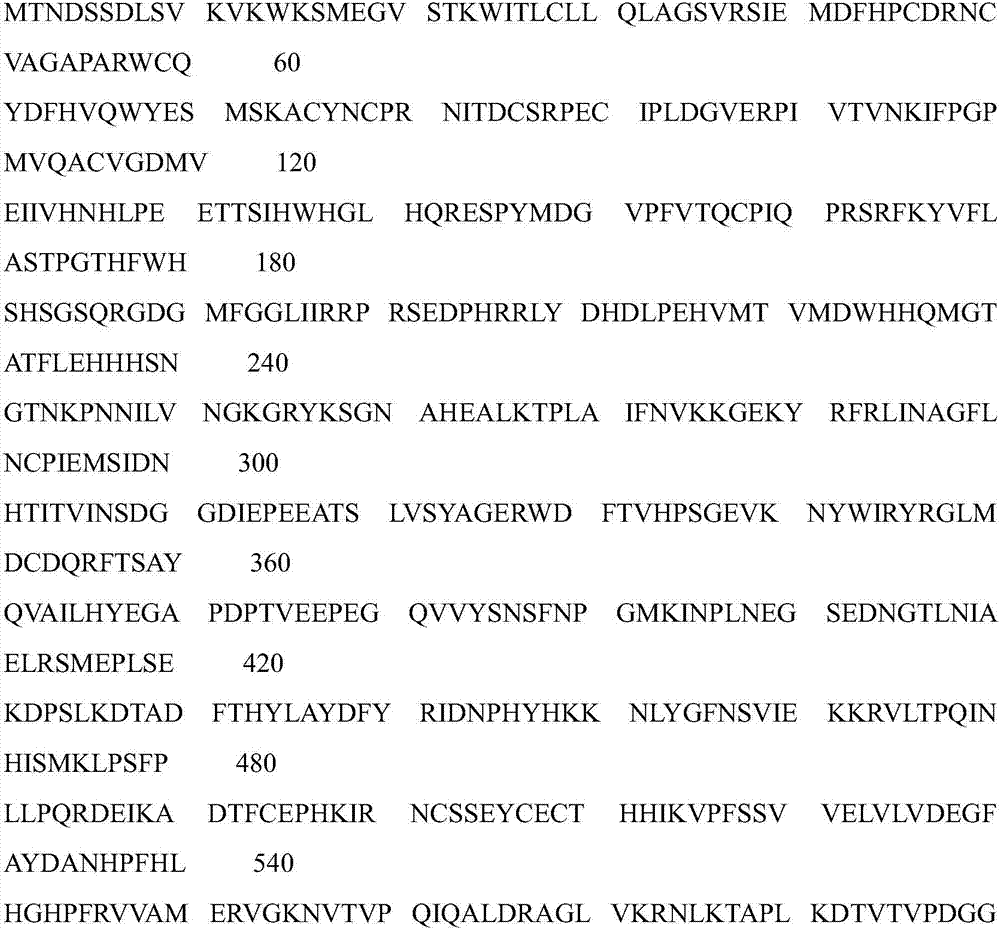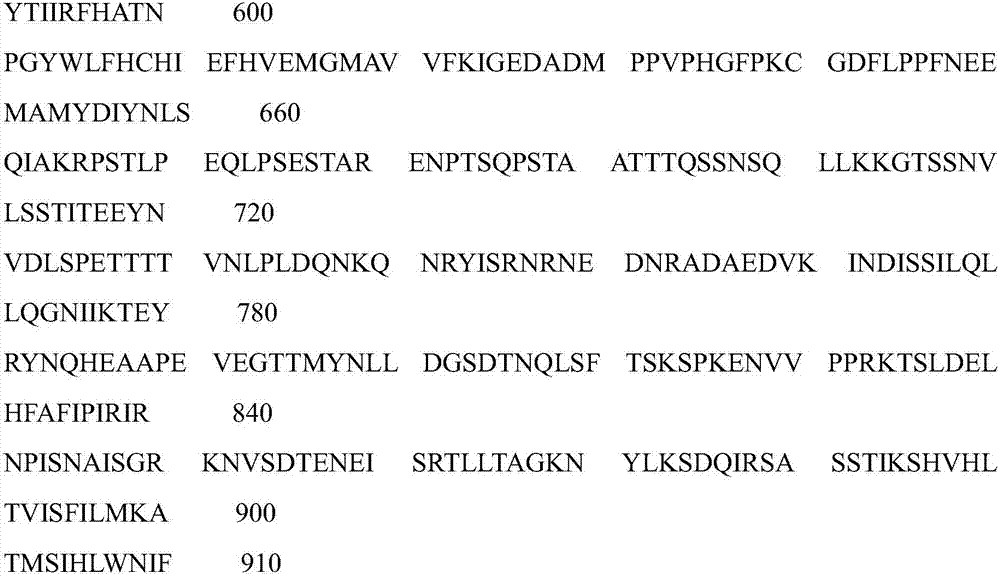Bemisia tabaci MED (Mediterranean) cryptic species laccase LAC1 (laccase 1) and gene and application thereof
A Bemisia tabaci and gene technology, applied in the field of genetic engineering, can solve problems such as protein sequence differences, gene function differences, etc.
- Summary
- Abstract
- Description
- Claims
- Application Information
AI Technical Summary
Problems solved by technology
Method used
Image
Examples
Embodiment 1
[0020] Example 1: Cloning of the full-length cDNA sequence of the Bemisia tabaci MED BtQLAC1 gene
[0021] 200 adults of Bemisia tabaci MED cryptic species were collected, RNA was extracted and stored in an ultra-low temperature refrigerator for future use. The cDNA was synthesized using the reverse transcription kit (Super Script First-Strand Synthesis System) of Transgen Company. Design primers MED BtQLAC1-F and MEDBtQLAC1-R:
[0022] BtQLAC-F:5'-CGCCTCTAGCGATTTTCAAC-3'
[0023] BtQLAC-R:5'-CGATGACTGGGTTGTTGTTG-3'
[0024] The middle fragment of MED BtQLAC1 gene of Bemisia tabaci MED cryptic species was amplified by PCR using cDNA as template. According to the middle fragment sequence of the obtained B. tabaci MED BtQLAC1 gene, 5'RACE and 3'RACE specific primers were designed to amplify the 5' and 3' end sequences of the MEDBtQLAC1 gene by PCR:
[0025] GSP1:5'-GCTGCTGTTGAGGGTTGACTTGTGG-3'
[0026] GSP2:5'-TCGAACCGGAAGAAGCAACCTCACT-3'
[0027] NGSP1:5'-F AGTTGCAGGAGGCA...
Embodiment 2
[0030] Example 2 Functional verification of MED BtQLAC1 gene
[0031] Select the more active adult individuals of two kinds of whiteflies raised with tomatoes as the source of test insects, randomly take 200, put them into a transparent glass tube (3 cm in diameter, 8 cm in height) at both ends, and cover the upper end of the glass tube with a double-layer Parafilm film Cover and carry out artificial rearing, and add 200 μL of feeding solution between the two layers of Parafilm, and the feeding solution is a mixture of 10% sucrose plus 10 mM MES dissolved in distilled water. In addition, the feeding solution without whitefly feeding was used as a control.
[0032] After 24 hours of feeding by whiteflies, use a disposable syringe to recover the feeding solution containing whitefly saliva and the feeding solution that has not been fed by whitefly. During the suction process, care should be taken to prevent the bottom membrane from breaking. The reaction was carried out at 28°C....
Embodiment 3
[0037] Example 3: Effect of dsRNA treatment of MED BtQLAC1 gene on survival rate of Bemisia tabaci MED on tomato
[0038] 1. Preparation of dsRNA template:
[0039] Primer sequence after adding T7 promoter (underlined sequence):
[0040] T7+MED BtQLAC1-F:
[0041] TAATACGACTCACTATAGGG ACTCATTTCTGGCACTCGCA;
[0042] T7+MED BtQLAC1-F:
[0043] TAATACGACTCACTATAGGG TCTTCCGGTTCGATGTCACC.
[0044] Total RNA extraction and cDNA synthesis: the same as in Example 1.
[0045] Perform PCR amplification with T7 primers, and then purify the product, and the purified PCR product is the template for synthesizing dsRNA.
[0046] 2. Synthesis and purification of dsRNA
[0047] use The RNAi Kit kit synthesizes and purifies dsRNA.
[0048] 3. dsRNA feeding
[0049]Take about 200 adults of the newly emerged whitefly MED cryptic species and put them into a glass tube with transparent ends. The upper end of the glass tube is covered with two layers of Parafilm membranes, and 20% sucr...
PUM
 Login to View More
Login to View More Abstract
Description
Claims
Application Information
 Login to View More
Login to View More - R&D
- Intellectual Property
- Life Sciences
- Materials
- Tech Scout
- Unparalleled Data Quality
- Higher Quality Content
- 60% Fewer Hallucinations
Browse by: Latest US Patents, China's latest patents, Technical Efficacy Thesaurus, Application Domain, Technology Topic, Popular Technical Reports.
© 2025 PatSnap. All rights reserved.Legal|Privacy policy|Modern Slavery Act Transparency Statement|Sitemap|About US| Contact US: help@patsnap.com



